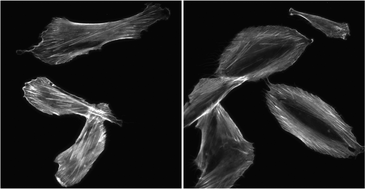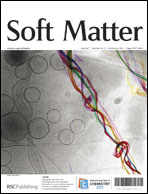Kinetic fingerprint discriminates similar cell populations subjected to uniaxial cyclic tensile strain on flexible substrates†
Abstract
Uniaxial cyclic tensile deformation of flexible cell culture membranes has been reported to induce cell body and cytoskeleton alignment with respect to the axis of the applied mechanical stimulus. This effect was proven to be strongly dependent on the stretching frequency and amplitude. However there is only little information available on cell type-specific responses. Extension of this stretching technique by live-cell imaging allowed us to investigate the temporal behavior of cells, which enabled us to define a cell-specific kinetic fingerprint. Based on this approach, we could identify significant differences between two periodontal cell populations closely related in vivo. The orientation response was shown to be faster for periodontal ligament fibroblasts than for alveolar bone cells. These results were substantiated by our observation of altered


 Please wait while we load your content...
Please wait while we load your content...